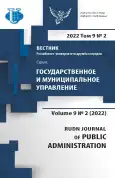Лидерство и совместное управление в переходный период от Целей развития тысячелетия к Целям устойчивого развития: систематическое картирование
- Авторы: Муслим М.А.1, Прасохо Э.1, Саломо Р.В.1
-
Учреждения:
- Университет Индонезия
- Выпуск: Том 9, № 2 (2022)
- Страницы: 172-188
- Раздел: МЕЖДУНАРОДНЫЙ ОПЫТ ГОСУДАРСТВЕННОГО УПРАВЛЕНИЯ
- URL: https://journal-vniispk.ru/2312-8313/article/view/318031
- DOI: https://doi.org/10.22363/2312-8313-2022-9-2-172-188
- ID: 318031
Цитировать
Полный текст
Аннотация
Лидерство является важным фактором в построении совместного управления, лидерские качества также влияют на эффективность текущего взаимодействия. Цель данной статьи - описать карту исследований лидерства и совместного управления с помощью Систематического картографического исследования (СКИ) в течение 5 лет. Этот период был выбран в связи с переходным периодом от Целей развития тысячелетия (ЦРТ) к Целям устойчивого развития (ЦУР). Проведенные исследования литературы охватывают период с 2013 по 2018 год. Результаты показали, что исследования лидерства и совместного управления сильно различаются, в связи с чем было проведено их сопоставление для выявления определенных тенденций. Наиболее широко используемый метод исследования - качественный. Тенденция публикаций показывает их очень значительный спад, особенно в 2013-2018 гг. Основываясь на этих результатах, показана важность проводить исследования в области лидерства с акцентом на совместные исследования в области управления, чтобы производить различные инновации и научные разработки в рамках объекта исследования.
Об авторах
Мух А. Муслим
Университет Индонезия
Email: muhazismuslim01@gmail.com
ORCID iD: 0000-0001-8768-9100
PhD, преподаватель кафедры государственного и муниципального управления, факультета административных наук
Индонезия, Джакарта, Западная Ява и Салемба, Депок, 16424Эко Прасохо
Университет Индонезия
Email: e_prasojo@yahoo.com
ORCID iD: 0000-0002-3904-0814
профессор кафедры государственного и муниципального управления факультета административных наук
Индонезия, Джакарта, Западная Ява и Салемба, Депок, 16424Рой В. Саломо
Университет Индонезия
Автор, ответственный за переписку.
Email: roy.v09@ui.ac.id
ORCID iD: 0000-0003-2501-7629
PhD, преподаватель государственного и муниципального управления факультета административных наук
Индонезия, Джакарта, Западная Ява и Салемба, Депок, 16424Список литературы
- Ansell C., Alison G. Collaborative Governance in Theory and Practice. Journal of Public Administration Research and Theory. 2008;8:543-71.
- Emerson K., Tina N., Stephen B. An Integrative Framework for Collaborative Governance. Journal of Administration Research and Theory. 2012;22(1):1-29.
- Sullivan H., Dan S.C. Working Across Boundaries; Collaboration in Public Services. New York: Palgrave Macmillan; 2002.
- Senge P. The Fifth Discipline: The Art and Practice of Learning Organization (revised edition). New York: Double D; 2007.
- Boon S.N., Geraldine C. Dynamic Governance, Embedding Culture, Capabilities and Change in Singapore. World Scientific Publishing Co. Pte. Ltd; 2007.
- Ricard L.M, Erik H.K., Jenny M.L., Tamyko Y. Assessing Public Leadership Styles for Innovation: A Comparison of Copenhagen, Rotterdam and Barcelona. Public Management Review. 2017;19(2):134-156.
- Ogbonna E., Lloyd C.H. Leadership Style. Organizational Culture and Performance: Empirical Evidence from UK Companies. Journal of Human Resource Management. 2000;11(4):766-788.
- Robbins S.P. Essentials of Organizational Behavior (2nd Ed). New Jersey: Prentice-Hall International, Inc; 1988.
- Peters B.G. Meta-Governance and Public Management. Dalam: Osborne, Stephen P. (Ed.). The New Public Governance: Emerging Perspectives on Theory and Practice of Public Governance. New York: Routledge; 2010.
- Bertocci D.I. Leadership in Organizations: There Is a Difference between Leaders and Managers. Lanham: University Press of America, Inc; 2009.
- Kartono K. Leader and Leadership, What Is the Abnormal Leader. Jakarta: PT. Raja Grafindo Persada; 2009.
- Yukl G. Leadership in Organization. Translated by: Sampe Maselinus, Rita Tondok Andarika. Second Edition. New Jersey: Prentice-Hall, Inc; 2009.
- Covey S.R. The 7 Habits of Highly Effective People. Tangerang: Binarupa Aksara Publisher; 2011.
- Stephen P. Integrative Leadership for Collaborative Governance: Civic Engagement in Seattle. The Leadership Quarterly. 2010;21(2):246-263.
- Heather G., Ricardo S.M. Collaborative Leadership Development for Local Government Officials: Exploring Competencies and Program Impact. Public Administration Quarterly. 2013;37(1):7-102.
- Purdy J.M. A Framework for Assessing Power in Collaborative Governance Processes. Public Administration Review. 2012;72:409-417.
- Emerson K., Tina N. Collaborative Governance Regimes. Washington DC: Georgetown University Press; 2015.
- McDougall C., et.al. Does Adaptive Collaborative Forest Governance Affect Poverty? Participatory Action Research in Nepal’s Community Forests. Society & Natural Resources. 2013;26(11):1235-1251.
- Wellbrock W. Operational Interfaces. A Key to More Collaborative Modes of Governance. Wageningen: Wageningen University; 2013.
- Kitchenham B.A., Dyba T., Jorgensen M. Evidence-based Software Engineering. IEEE Computer Society. 2004; 1: 273-281.
- Kitchenham B., Charters S. Guidelines for Performing Systematic Literature Reviews in Software Engineering. Technical Report EBSE-2007-01. School of Computer Science and Mathematics, Keele University; 2007.
- Petersen K., et al. Systematic Mapping Studies in Software Engineering. 12th International Conference on Evaluation and Assessment in Software Engineering; 2008.
- Banaeianjahromi N., Smolander K. What do We Know about the Role of Enterprise Architecture in Enterprise Integration? A Systematic Mapping Study. Journal of Enterprise Information Management. 2016;29(1):140-164.
- Purbasari R., Wijaya C., Rahayu N. The Entrepreneurial Ecosystem as A Network-Rich System: A Systematic Mapping Study. Academy Of Entrepreneurship Journal; Arden. 2019;25(2):1-17.
- Muslim M.A., Prasojo E., Jannah L.M. Collaborative Governance for Poverty Alleviation: A Systematic Mapping Study. RUDN Journal of Public Administration. 2021;8(1):20-36.
- Musianto L. The Difference Between the Quantitative Approach and Qualitative Approach in The Research Method. Jurnal Manajemen & Kewirausahaan. 2002;4(2):123-126.
- Wieringa R., Maiden N., Mead N., Rolland C. Requirements Engineering Paper Classification and Evaluation Criteria: A Proposal and a Discussion. Requirements Engineering. 2006;11(1):102-107.
Дополнительные файлы










